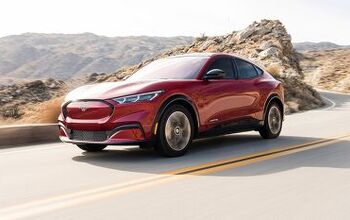Jaguar Land Rover Wants to Build Cars in the U.S., but Only If Americans Buy More

Jaguar Land Rover says it’s totally stoked at the idea of establishing a production facility in the United States, but claims Americans will probably need to buy a few more cars before that vision can become a reality. This might not be a problem, as U.S. buyers have been all about JLR lately. Group sales were the best in over fifteen years in 2016 and last year saw the company achieve a record high of 114,333 deliveries.
While the majority of those sales come from Land Rover, Jaguar has also seen impressive growth over the last three years. More North American sales are definitely coming, especially with Rover already looking to have one of its best years on record in just the first three months of 2018. So why won’t the manufacture pull the trigger and start laying the groundwork on a new factory?
According to CEO Ralf Speth, Jaguar Land Rover doesn’t see itself as a large enough automaker to make big moves without some very careful planning. In a recent interview with Wards Auto, Speth said he still feels JLR is a “very small company.”
“We need a certain volume of vehicles to be sold in the U.S. to make the overall production in the U.S. viable,” he said.
When pressed about Volvo’s decision to set up an assembly plant in South Carolina, despite delivering just 81,504 vehicles in the U.S. last year, the CEO didn’t see the equivalency. “Everybody’s business case is different and everybody starts maybe in a different way,” he said. “I don’t want to discuss the advantages or disadvantages of Volvo. We really need to find our own way.”
We don’t think it’s an unfair comparison. Both companies have similarly sized parent companies (Tata for JLR, Geely for Volvo) and sell to roughly the same consumer base. It’s not a perfect comparison, but we can’t think of many better.
Jaguar Land Rover’s way forward doesn’t just involved improving sales. Speth says a dominant model will need to emerge on the U.S. market before the company can build a factory there. While the F-Pace is the clear standout for Jaguar, practically everything in Land Rover’s lineup moves between 10,000 and 20,000 annual units in the United States.
“We have 15 or 16 nameplates … if you divide every and each number by this 15 or 16 then you will recognize the remaining number per nameplate is not big enough,” Speth explained. “So can you maybe encourage [sales and marketing and dealers] to sell a little bit more from at least one or two nameplates?”
The company is already making commitments to America, however. In addition to its new new U.S. headquarters in Mahwah, NJ, Jaguar will supply 20,000 examples of its I-Pace battery-electric CUV to Waymo for use in its autonomous fleet. Those cars won’t be coming until 2020, so the brand could have set up shop in North America, given that the U.S. is one of its target markets. But Magna Steyr, which was tapped to manufacturer the vehicle for JLR, understandably decided to build it in Graz, Austria, next to the E-Pace.
However, that facility is already stretched pretty thin; it recently began construction auxiliary factory in Slovenia to help with production. If I-Pace demand exceeds expectations in North America, and JLR can pin down another volume model, perhaps the U.S. will get that factory after all.
[Images: JLR]

A staunch consumer advocate tracking industry trends and regulation. Before joining TTAC, Matt spent a decade working for marketing and research firms based in NYC. Clients included several of the world’s largest automakers, global tire brands, and aftermarket part suppliers. Dissatisfied with the corporate world and resentful of having to wear suits everyday, he pivoted to writing about cars. Since then, that man has become an ardent supporter of the right-to-repair movement, been interviewed on the auto industry by national radio broadcasts, driven more rental cars than anyone ever should, participated in amateur rallying events, and received the requisite minimum training as sanctioned by the SCCA. Handy with a wrench, Matt grew up surrounded by Detroit auto workers and managed to get a pizza delivery job before he was legally eligible. He later found himself driving box trucks through Manhattan, guaranteeing future sympathy for actual truckers. He continues to conduct research pertaining to the automotive sector as an independent contractor and has since moved back to his native Michigan, closer to where the cars are born. A contrarian, Matt claims to prefer understeer — stating that front and all-wheel drive vehicles cater best to his driving style.
More by Matt Posky
Latest Car Reviews
Read moreLatest Product Reviews
Read moreRecent Comments
- MaintenanceCosts The crossover is now just "the car," part 261.
- SCE to AUX I'm shocked, but the numbers tell the story.
- SCE to AUX "If those numbers don’t bother you"Not to mention the depreciation. But it's a sweet ride.
- Shipwright Great news for those down south. But will it remove internal heat to the outside / reduce solar heat during cold winter months making it harder to keep the interior warm.
- Analoggrotto Hyundai is the greatest automotive innovator of the modern era, you can take my word for it.



































Comments
Join the conversation
Make what Americans want and more people will buy them. But from what we've seen so far, their reliability will have to move significantly higher on the chart.
For me to buy another Jag or even a RR, the vehicles would have to approach the reliability of a Toyota/Lexus model.